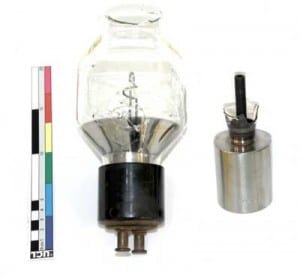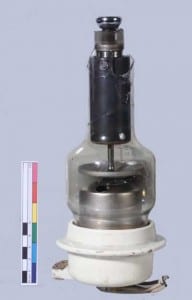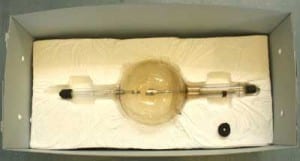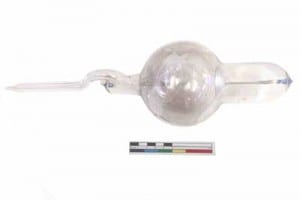Conserve It! Part IV – Filling and Finishing Touches
By Nick J Booth, on 5 July 2013
This is the final installment of the excellent Conserve it! blog series, written by four conservation students from the Institute of Archaeology. In this post Leslie Stephens and Louise Stewart describe the last stages of the process.
To read the full series please click on the ‘Engineering Collections’ or ‘Science Collections’ category tabs on the left hand side of this page.
Conservation doesn’t end when all the pieces are back together. Once researched, cleaned and reassembled, the x-ray tubes will need further work. Filling gaps and preparing the tubes for storage are the final stages in the process.
Why do conservators fill gaps in objects? Fills are usually undertaken for two reasons: aesthetics and support. When an object has most of its pieces remaining, it is frequently the job of the conservator to make an object look as complete as possible so that visitors are aided in its visual interpretation. When the object’s original material is fragmentary, it is often difficult for visitors to understand what it would have looked like before damage. The more material is missing, the harder this job is for the conservator. There is a fine line between aiding interpretation for the visitor, and presenting an object that is too much ‘interpretation’ and not enough original material. If the conservator is not certain what the missing fragments would have looked like, they are less likely to fill that area with a ‘guess’. When there is very little original material left, however, fills sometimes hold fragments in place. This happens especially when there is not enough original material left for the object to hold its own weight; these types of fills are considered support fills.
As a principle of conservation it is usual to make any fill material look similar but not exactly like the real thing. While the convention in ceramics (like ancient Greek vases seen in museums the world over) is to paint the fill a slightly lighter shade, for our x-ray tubes, this is not an option.
Fills on glass are notoriously complicated and require time and patience. On clear glass such as ours, the material used must look like glass, have the right color, and even reflect light at a similar angle, a quality known as the refractive index. Materials used as fillers for glass objects include epoxy resins, acrylic resins, and polyester resins. We choose a material by many criteria including its aging properties (most options yellow with time), its curing time, its refractive index, how it handles changes in its surrounding environment like temperature and humidity, and its ease of use while working it in the lab.
Resins are cast by making silicon rubber moulds to make a negative of the missing piece in the object and then pouring the resin inside and allowing it to cure (Figure 1). Once made, which may take many attempts to get just right, the new piece can be fitted in like an original fragment.

This mold made a clear epoxy resin ‘button’ that went between two heavy pieces of one tube to provide support and hold them together.
Each of the x-ray tubes needed a slightly different approach to reassembly and support. In the end, none had gaps in the glass large enough or unstable enough to require filling. Two of the x-ray tubes, Kate’s and Louise’s, however, had the issue of having two very heavy parts. In the end, it was not possible for Kate’s x-ray tube to be reassembled in one part (Figure 2). The glass fragments that originally connected and supported the metal interior piece (on the right side of Figure 2) were missing, and even a fill would not have provided enough structural stability, due to the weight of the pieces involved and the small area the fill would have occupied. This presents an interesting interpretation of the object, however, allowing the viewer to see the interior coiled mechanism, which would have been covered by the cylinder if the object was whole.

The broken glass at the top of the metal piece would originally have joined with the broken glass at the narrow top of the tube, suspending the metal cylinder over the interior coil.
Louise’s x-ray tube faced a similar issue, with a heavy metal cylinder that was once suspended inside the glass bulb. However, since the heavy fragments had two flat surfaces facing each other, it was possible to make a ‘button’ out of clear epoxy resin, which supports the metal core above the base of the object. This allows the object to be stored as one piece, despite the fact that the glass that originally would have completed the bulb and held the fragments together is still missing. Part of the reason that this was seen as an acceptable treatment is that the buttons are fairly unobtrusive; they don’t detract from the completeness of the object.

The support button cast from the mould in Figure 1 can be seen (but only a little) between the metal disc and the metal cylinder. Another smaller button is visible between the black cylinder and the glass, near the top of the object.
Miriam’s and Leslie’s x-ray tubes (Figures 4 and 5) did not require any fills or structural support in this manner, as the gaps that they had were very small and did not affect the structural stability of the object. The work required in the reconstruction of these two objects was significant- they each had thin glass, with an enormous number of fragments.
Once the x-ray tubes were reassembled, they needed to be packaged and readied for sending back to the museum. Our x-ray tubes, because they do not stand upright on their own (none has a flat base to sit on) must be packaged so that each part is supported. The storage boxes created are able to support the weight of objects evenly, to minimize strain that may otherwise be put on unsupported areas.

The extra square areas on the side of the cylindrical glass are hand-holes, spaces for the glass to be grasped when lifting the object out of the packaging.
It is important that all materials used in the building of storage boxes by archival quality; the Coolidge Tube in Figure 5 is shown in an archival blue board box, resting on its purpose built foam support. The foam has been covered in Tyvek, a non-woven polyethylene textile, which provides extra support and cushioning for the object, but is smooth enough that there is nothing that the object could ‘catch’ on. When the box is closed, two Tyvek pillows, filled with soft polystyrene balls, are placed on top, to protect the object in case of shaking or a fall. Each of the tubes was packaged similarly, providing support and protection for storage, transport, and potentially handling.
With all that, the treatments are complete! Each of the objects is now ready for return to the UCL Medical Physics collection. We all really enjoyed treating these complex objects, and being able to bring these treatments to you!
I would like to take this opportunity to say a big thank you to Leslie Stephens, Louise Stewart, Katherine Becker and Miriam Orsini for their fantastic work on both the objects and this blog series. Just under a year ago I took a box full of smashed glass to their conservation labs. I now have four Museum Objects that can be used again for Teaching, Research and Display. To a non-conservation type person like me this feels a bit like some sort of magic. Nick.
 Close
Close


